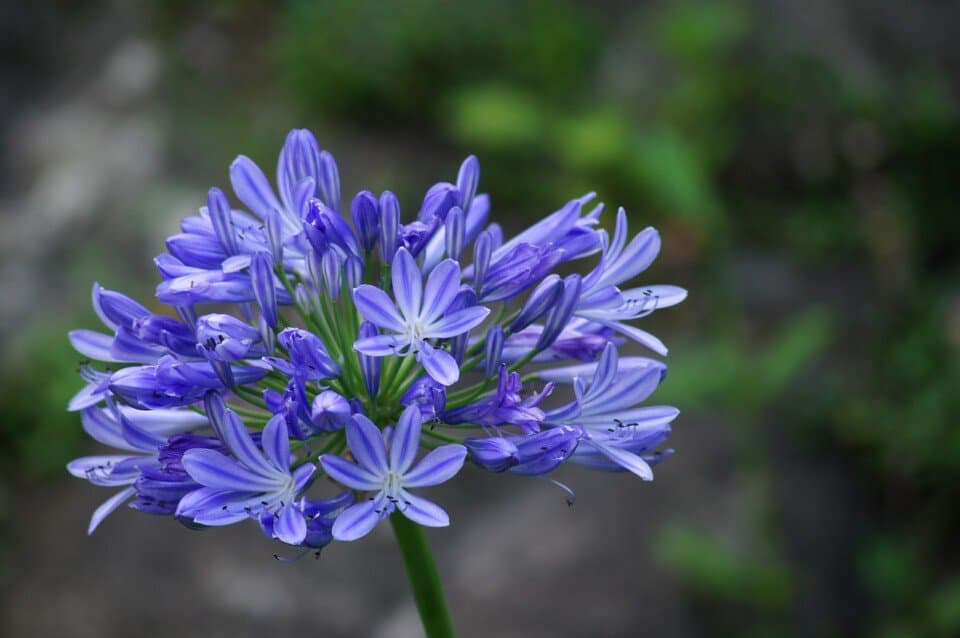Some links in the post are affiliate links and I get a commission from purchases made through some links found in the post.
The agapanthus is also known as the blue African lily. And by that alone, you can already know that you should enjoy some lovely blue flowers when the plant finally blooms.
But not everyone gets to experience this. Sometimes, you sit by and count the months, watering and feeding the plant, and you get nothing.
Why does this happen, and how can you avoid it? The good news is that encouraging your agapanthus to flower is not hard. It takes just a few requirements and a great deal of patience.
The reasons your agapanthus is not flowering is due to transplant shock, frost damage, not getting enough food and not getting the right amount of light.
If there is too much winter warmth, it’ll lead to your agapanthus flowering early which in turn will lead to poor flower quality.
I will show you just how you can go about sorting these in this guide
What Month Does Agapanthus Flower?
The fun starts at this point. You might expect that because your neighbor’s agapanthus has bloomed, yours should follow suit. But it does not work this way. You’ve got to keep in mind two important factors.
1) The breed of your agapanthus
There are many agapanthus species, from the Africanus down to the A. Orientalis. And guess what? Their bloom times are different.
Some start blooming towards the end of spring, while others start towards the end of summer. Most species will bloom within this period. However, some keep blooming till the fall.
2) The state of your agapanthus
 This does not refer to whether it’s well-watered or well-fed. Instead, it comes down to if the agapanthus has bloomed in the past.
This does not refer to whether it’s well-watered or well-fed. Instead, it comes down to if the agapanthus has bloomed in the past.
Reblooming plants will keep doing so throughout the growing season and will only stop in the winter when they need to relax. But those that have just started blooming will do so for about two to three weeks.
So, if your agapanthus is yet to flower, it could be that its time has not arrived.
But if fall comes around and the plant has still not bloomed, it will likely not produce any blooms, and you must start questioning why this could be the case.
Does Agapanthus Flower Every Year?
The answer to this question also varies. Why? It depends on how the plant was grown. In most cases, people grow the agapanthus by dividing an already mature plant.
In this instance, the agapanthus should start flowering in its first year, though the blooms may be few. And sometimes, the agapanthus takes a while to establish itself and starts flowering the next year.
After all, it must take time to adapt to the weather and other conditions. Often, agapanthus plants grown outdoors take about a year to acclimate.
But those grown in controlled conditions (indoors) take to their new homes with ease and start flowering the first year.
How about agapanthus plants grown from seeds? It’s not often that gardeners will grow the agapanthus from seed – that’s because such plants take up to 4 years to mature enough to start flowering.
So, you cannot expect your plant to flower for the next three to four years.
After an agapanthus has started flowering, it should continue doing so every year until it dies. Of course, this also depends on the existing conditions.
Does it have enough water? How about sun exposure? And feeding? We will look at how these factors may affect blooming in the next section.
You may also like: Why are your agapanthus leaves turning yellow & fixes
Why Is Your Agapanthus Not Flowering, and How Can You Fix It?
So, your cloned agapanthus has not flowered in its first year – it’s probably still dealing with transplant stress. But then the second year goes by, and you still get nothing.
What could be the issue? Let’s uncover the underlying causes of this gardener’s nightmare:
a. Your Agapanthus is in Transplant Shock
Imagine growing up in a hot climate, then one day, someone moves you to a cold country. How long would it take for you to acclimate to the new environment?
You would likely suffer a few flu touches and need to change your wardrobe. And this would not happen overnight. Well, that is the case with the agapanthus.
This plant is native to Africa, where the conditions are warm. And before you take it home with you, it usually grows in greenhouses or nurseries under controlled conditions.
So, the minute you introduce it to your outdoors, it takes a while to get used to the new environment with such direct exposure to the elements. See? Plants are pretty much like humans in some of these aspects.
Transplant stress can occur in many cases. These include:
- When you repot your agapanthus in a bigger pot after it has been rootbound or after you get it from the nursery, or
- When you move the agapanthus from a controlled environment to the outdoors.
How does it work? Whenever a plant feels threatened by its new environment, it focuses on growing more leaves to make enough food to withstand the new conditions.
So, your agapanthus starts acclimating, and it will show more foliage with few or no flowers.
Can You Fix Transplant Shock?
Sure! The most important thing to do when your plant is in shock is to (wait for it) give it time to acclimate.
As you allow it to do this, you can ensure it has access to all it needs – water, light, and nutrients. It uses this trifactor to build a strong immune system which allows it to produce healthy blooms the next season.
Another thing that helps is to repot the agapanthus in the spring. Why? The agapanthus goes into a dormant stage in the winter and starts growing in the spring.
If you repot it when it’s actively growing, it can acclimate in time to produce healthy blooms. It’s a bit of a long shot, but it works for plants that have been repotted to bigger pots but in the same environment.
If you’re moving your plant from a nursery to the outdoors and still changing its pot, the shock might be too much for it to get over by the end of spring.
b. Your Agapanthus Has Suffered Frost Damage
 The agapanthus is not native to cold regions and takes a while to get used to such conditions. But even after acclimation, it does not become frost tolerant as this is another ballpark.
The agapanthus is not native to cold regions and takes a while to get used to such conditions. But even after acclimation, it does not become frost tolerant as this is another ballpark.
That’s why it’s best grown in USDA zones 8 to 10. If you grow it outdoors in lower zones, you leave it exposed to the cold drafts in the winter.
And these winds damage the flower buds that your agapanthus has already formed in the fall. As a result, when spring comes about, the plant has nothing to show for it.
Can You Fix It?
Yes – this is an easy problem to deal with, as follows:
- If you live in zones below USDA 8 to 10, you can grow your agapanthus outside between the last frost and two weeks before the first frost. Ideally, this should be between the mid of spring and mid of fall. Then when fall starts to end, move the plant indoors where you can control the temperatures. And keep it away from windows and doors where the winter drafts can get to it.
- If you live in zones 8 to 10, you can leave the agapanthus outside, provided that the winter temperatures are not too cold. But you should leave the plant sheltered from the winds to protect the flower buds. You can do this by covering the plant with mulch or a cloth. You can then remove the barrier in the spring to allow the agapanthus to start flowering.
Ideally, you should not plant the agapanthus in the ground, as this would limit how much you can move it when the temperatures become too cold.
You may also like: 5 great planting combinations with your agapanthus
c. Your Agapanthus Needs More Feeding
Does your agapanthus ever need feeding? Oh yes, it does! Your plant needs three key things to make food – water, nutrients, and light.
And in the growing season, it needs more nutrients because it makes both foliage and flowers. When the plant lacks enough nutrients, it focuses more on making leaves than flowers.
So, you end up with a healthy-looking plant that has no blooms. But if it has enough nutrients, the blooming is quite aggressive.
But the availability of nutrients is not all that matters – the type of nutrients also plays a vital role in this process.
How so? A feed that is high in nitrogen emphasizes foliage production over flowering. So, your plant may have enough nutrients but has nitrogen in abundance.
Can You Fix This?
Sure! Start by understanding what nutrients are in the potting or soil mix by conducting a soil test. Does the soil have too much nitrogen? Does it lack potassium? What is the issue? Then you can proceed as follows:
- If the plant generally lacks nutrients, you should use a well-balanced NPK feed with ratios of 10:10:10. It should be a week liquid feed that slowly seeps into the soil to avoid damaging the roots. If the plant has too much nitrogen, use a feed with lower or no nitrogen components.
- Only feed the plant with an NPK feed towards the start of spring and in the following weeks. And once the flowers appear, stop amending the soil and allow the plant to use what is already in the soil. When the flowers fall off, follow up with a feed that is high in potash, as this will encourage the development of healthy buds.
- Please do not feed the plant in the winter as this will only damage the roots as they cannot absorb nutrients when they are in the dormant phase.
You can always use organic matter to feed the plant using the recommendations above. Please note that potted plants rely on you to amend their soils as they cannot access the nutrients in any other way.
d. Your Agapanthus Needs More Sun
The agapanthus generally does well in bright and indirect light. But in the summer, this is not enough to encourage healthy flowering.
Why is that? Flowering requires the agapanthus to have a lot of energy, which it gets via photosynthesis.
And the light is responsible for providing the photons that impart energy to the agapanthus to trigger this chain reaction.
Bright and indirect light does not have enough photons to sustain this process, and the resultant flowers will either be few or unhealthy.
Can You Fix This?
 The easiest way to deal with inadequate light exposure is to move the plant to a bright and sunny position. Here is what you can do:
The easiest way to deal with inadequate light exposure is to move the plant to a bright and sunny position. Here is what you can do:
- If the plant is indoors, you can move it outdoors to allow it to access more light. The plant will need at least six hours of full sun. You can thus position it towards the east of the garden or towards the south (if you live in the northern hemisphere). If moving the plant outdoors is not ideal, you can push the plant against an east or south-facing window where it can access more light. If it still does not flower well, you may need to move it under artificial lighting to supplement what it gets.
- Outdoor plants should not have an issue accessing light. You can check to ensure barriers are not shading them.
Should you transplant your agapanthus to a sunnier location? No- doing this would stress the agapanthus and affect its flowering phase. If the plant does not need repotting, avoid doing so until the spring.
Final Thoughts
What’s the last part of the trifactor? – water. Without this, your agapanthus will not flower.
Please note that watering needs will increase in the summer, especially after moving the plant to a sunnier location. You must water the plant whenever the top two inches of the soil feel dry.
Happy Gardening!


